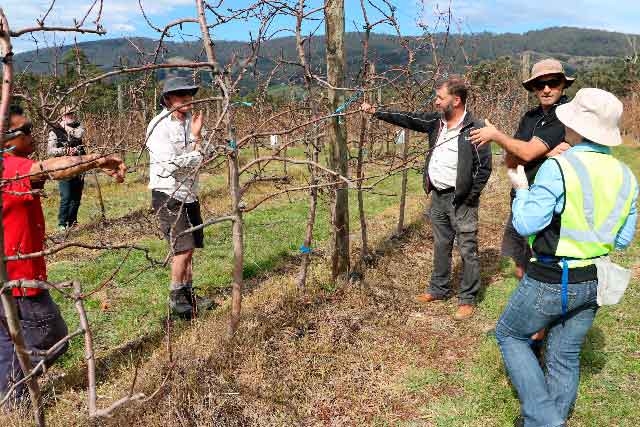Achieving optimal crop loads every year is not easy. Good results can be obtained from chemical thinning but variable spring weather in most Australian apple growing regions means tree response can be unpredictable.
This unpredictability combined with environmental concerns associated with some thinning chemicals has sparked an interest in finding alternatives to chemical thinning.
ASE—an alternative to chemical thinning
The concept of Artificial Spur Extinction (ASE) for management of crop load was developed by Dr Stuart Tustin and his group in New Zealand. It is based on observations by a French research group that found that regular bearing cultivars have high natural spur extinction.
Work with ASE in Australia over the past few years has shown that it is a suitable tool for precision management of crop load without additional chemical thinning.
It has marked advantages in that it is not weather dependent and it removes the negative impact that most chemical thinners have on fruit size and shape.
In addition, bud position is optimised in ASE, fruit is well spaced and light distribution into the canopy is enhanced.
With this technology, growers are also able to set their trees up to carry a predetermined crop load with reasonable accuracy, thus enabling improved management of fruit size.
Cost:benefit analysis to come
A full cost:benefit analysis is still to be completed taking into account time of pruning and bud removal, cost of spraying, hand thinning etc.
However, our results indicate the potential of ASE to supersede and eliminate the present requirements for chemical thinning to regulate biennial bearing and crop loading.
Although the first year of ASE implementation can be labour intensive, in the longer term the application of ASE with its simplified hand-thinning and more even fruit maturity, combined with a move away from chemical thinning, is likely to reduce both time and cost to the grower.
The study: comparing ASE to regular pruning
This project compared the impact of ASE, with conventional pruning management on fruit set response, yield and fruit quality across a number of Australian growing regions.
It demonstrates that ASE is a feasible crop load management tool under Australian conditions.
The study takes an original study one step further by examining ASE in conjunction with chemical thinning on Gala and Fuji apples and aims to answer these questions:
Is ASE effective on cultivars with an extreme biennial bearing tendency, such as Fuji
How do ASE managed trees respond to chemical thinners
Can ASE technology be successfully merged with chemical thinning to optimise yields and fruit quality
How does ASE technology compare directly with best practice chemical thinning programs in terms of yield, pack-outs, and cost:benefit.
What is ASE?
Artificial Spur Extinction (ASE) is a crop load management method using bud thinning techniques to precisely define where and how much fruit is set on each limb of the tree.
The aim of ASE is to promote the vigour and performance of floral spurs, stimulate spur strength and improve fruit quality and regularity of production.
Initial setup
The initial setup of trees for ASE begins with winter pruning to remove unbalanced (large) limbs and space limbs out so there is a maximum of 6-7 limbs per metre of tree height.
To optimise fruiting whilst restricting excessive vegetative growth, remaining limbs are trained to a near horizontal position.
Floral spurs are then selectively removed prior to bud break to precisely define the density and location of potential fruit on the tree.
The number of flower buds left on each limb is based on the diameter of the limb, so that a strong branch carries more fruit and vice versa.
This means that at bud burst ASE managed trees commence spring growth in an already significantly ‘crop thinned’ state, carrying fewer but stronger flower buds than conventionally managed trees.
As there is less competition, more resources are directed to fruit buds that will go on to produce fruit rather than thinnings on the ground.
ASE also simplifies and speeds up the job of hand thinning as spacing, position and number of clusters are already set by the bud thinning process—all that is required is to break up fruit bunches and remove fruit with defects..
About the trials (cont next month)
See this article in Tree Fruit Sept 2017






















